Sixteen Years since the Convention on the Rights of Persons with Disabilities: What Have We Learned since Then?
Abstract
:1. Introduction
- Q1. What are the main characteristics of the line of research?
- Q2. Which are the most influential publications?
- Q3. Who are the most prolific contributors (journals, authors, institutions, and countries)?
- Q4. What is the trend in collaboration (authors, institutions, and countries)?
- Q5. Who are the main subjects and what are the research trends?
2. Methods and Materials
2.1. Methodology Applied to the Data Analysis
2.2. Procedure of the Bibliometric Analysis
2.2.1. Identification Stage
2.2.2. Analysis and Visualization Stage
2.2.3. Results and Discussion Stage
3. Main Characteristics of Scientific Production and the Most Influential Publications (Q1 and Q3)
4. Contributions and International Cooperation Networks (Q3 and Q4)
5. Research Topics and Trends in Social Inclusion and Disability (Q5)
- Digital accessibility
- 2.
- Community participation
- 3.
- Education and independent living
- 4.
- Work
- 5.
- Barriers to social inclusion
- 6.
- Social support and quality of life
6. Conclusions
Author Contributions
Funding
Institutional Review Board Statement
Informed Consent Statement
Conflicts of Interest
References
- Metts, R.L. Disability Issues, Trends, and Recommendations for the World Bank; World Bank: Washington, DC, USA, 2000. [Google Scholar]
- Elwan, A. Poverty and Disability: A Survey of the Literature; World Bank: Washington, DC, USA, 1999. [Google Scholar]
- Martínez-Rios, B. Pobreza, discapacidad y derechos humanos. Rev. Española Discapac. 2013, 1, 9–32. [Google Scholar] [CrossRef]
- World Health Organization (WHO). World Report on Aging and Health; World Health Organization: Geneva, Switzerland, 2015. [Google Scholar]
- Witcher, S. Reviewing the Terms of Inclusion: Transactional Proccesses, Currencies and Context; The London School of Economics and Political Science: London, UK, 2003. [Google Scholar]
- Moriña-Díez, A. Vulnerables al silencio. Historias escolares de jóvenes con discapacidad. Rev. Educ. 2010, 353, 667–690. [Google Scholar]
- Brandolini, A.; D’Alessio, G. Measuring well-being in the functioning space. In Proceedings of the General Conference of The International Association for Research in Income and Wealth, Cracow, Poland, 23–29 August 1998; pp. 1–67. [Google Scholar]
- Jiménez, A.; Huete, A. La Discriminación por Motivos de Discapacidad; CERMI: Madrid, Spain, 2003. [Google Scholar]
- Kronauer, M. Social exclusion and underclass—New concepts for the analysis of poverty. In Empirical Poverty Research in a Comparative Perspective; Hans-Jurgen, A., Ed.; Ashgate: Farnham, UK, 1998; pp. 51–75. [Google Scholar]
- Levitas, R. The Inclusive Society? Social Exclusion and New Labour; Palgrave Macmillan: London, UK, 2005. [Google Scholar]
- Tezanos, J.F. Tendencias de dualización y exclusión social en las sociedades tecnológicas avanzadas. Un marco para el análisis. In Tendencias en Desigualdad y Exclusión Social; Tezanos, J.F., Ed.; Editorial Sistema: Madrid, Spain, 2004. [Google Scholar]
- Sen, A. Capabilities, Lists, and Public Reason: Continuing the Conversation. Fem. Econ. 2004, 10, 77–80. [Google Scholar] [CrossRef]
- UNESCO Incheon Declaration. Education 2030: Towards Inclusive and Equitable Quality Education and Lifelong Learning for All; UNESCO: London, UK, 2015. [Google Scholar]
- Critten, V.; Critten, V. Expectations and realisations: The employment story of a young man with cerebral palsy. Disabil. Soc. 2016, 31, 573–576. [Google Scholar] [CrossRef]
- Darcy, S.; Taylor, T.; Green, J. ‘But I can do the job’: Examining disability employment practice through human rights complaint cases. Disabil. Soc. 2016, 31, 1242–1274. [Google Scholar] [CrossRef]
- Wiggan, J. Telling stories of 21st century welfare: The UK Coalition government and the neo-liberal discourse of worklessness and dependency. Crit. Soc. Policy 2012, 32, 383–405. [Google Scholar] [CrossRef]
- Gordon, P.A.; Tantillo, J.C.; Feldman, D.; Perrone, K. Attitudes Regarding Interpersonal Relationship with Persons with Mental Illness and Mental Retardation. J. Rehabil. 2008, 70, 50–56. [Google Scholar]
- Miller, E.; Chen, R.; Glover-Graf, N.M.; Kranz, P. Willingness to Engage in Personal Relationships With Persons With Disabilities. Rehabil. Couns. Bull. 2009, 52, 211–224. [Google Scholar] [CrossRef]
- Siperstein, G.N.; Parker, R.C.; Bardon, J.N.; Widaman, K. A National Study of Youth Attitudes toward the Inclusion of Students with Intellectual Disabilities. Counc. Rev. 2007, 73, 435–455. [Google Scholar] [CrossRef]
- Howard, M. Enabling Government: Joined Up Policies for a National Disability Strategy; Fabian Society: London, UK, 1999. [Google Scholar]
- Villa, N. La Inclusión Progresiva de las Personas con Discapacidad Intelectual en el Mundo Laboral; Ministerio de Trabajo y Asuntos Sociales: Madrid, Spain, 2007.
- Lindsay, S.; McPherson, A.C.; Maxwell, J. Perspectives of school-work transitions among youth with spina bifida, their parents and health care providers. Disabil. Rehabil. 2017, 39, 641–652. [Google Scholar] [CrossRef]
- Rutkowski, S.; Riehle, E. Access to Employment and Economic Independence in Cerebral Palsy. Phys. Med. Rehabil. Clin. North Am. 2009, 20, 535–547. [Google Scholar] [CrossRef] [PubMed]
- Wolgemuth, J.R.; Agosto, V.; Lam, G.Y.H.; Riley, M.W.; Jones, R.; Hicks, T. Storying transition-to-work for/and youth on the autism spectrum in the United States: A critical construct synthesis of academic literature. Disabil. Soc. 2016, 31, 777–797. [Google Scholar] [CrossRef]
- Kenway, P.; Fuller, S.; Rahman, M.; Street, C.; Palmer, G. Monitoring Poverty and Social Exclusion in Scotland; Joseph Rowntree Foundation: York, UK, 2006. [Google Scholar]
- Welsby, J.; Horsfall, D. Everyday practices of exclusion/inclusion: Women who have an intellectual disability speaking for themselves? Disabil. Soc. 2011, 26, 795–807. [Google Scholar] [CrossRef]
- Mohapatra, S.; Mohanty, M. Abuse and Activity Limitation: A Study on Domestic Violence Against Disabled Women in Orissa, India; Oxfam (Inida) Trust: New Delhi, India, 2005. [Google Scholar]
- United Nations (UN). In-Depth Study on All Forms of Violence against Women; United Nations: New York, NY, USA, 2006. [Google Scholar]
- Cramm, J.; Finkenflügel, H. Exclusion of disabled people from microcredit in Africa and Asia: A literature study. Asia Pac. Disabil. Rehabil. J. 2008, 19, 15–33. [Google Scholar]
- Beisland, L.A.; Mersland, R. The use of microfinance services among economically active disabled people: Evidence from Uganda. J. Int. Dev. 2012, 24, S69–S83. [Google Scholar] [CrossRef]
- United Nations (UN). Convention on the Rights of Persons with Disabilities; United Nations: New York, NY, USA, 2006. [Google Scholar]
- United Nations (UN). Millennium Development Goals; United Nations: New York, NY, USA, 2015. [Google Scholar]
- World Health Organization (WHO). World Report on Disability; World Health Organization: Geneva, Switzerland, 2011. [Google Scholar]
- Abbott, S.; Mcconkey, R. The barriers to social inclusion as perceived by people with intellectual disabilities. J. Intellect. Disabil. 2006, 10, 275–287. [Google Scholar] [CrossRef]
- Kampert, A.L.; Goreczny, A.J. Community involvement and socialization among individuals with mental retardation. Res. Dev. Disabil. 2007, 28, 278–286. [Google Scholar] [CrossRef]
- Forrester-Jones, R.; Carpenter, J.; Coolen-Schrijner, P.; Cambridge, P.; Tate, A.; Beecham, J.; Hallam, A.; Knapp, M.; Wooff, D. The Social Networks of People with Intellectual Disability Living in the Community 12 Years after Resettlement from Long-Stay Hospitals. J. Appl. Res. Intellect. Disabil. 2006, 19, 285–295. [Google Scholar] [CrossRef]
- Johnson, H.; Douglas, J.; Bigby, C.; Iacono, T. Social Interaction with Adults with Severe Intellectual Disability: Having Fun and Hanging Out. J. Appl. Res. Intellect. Disabil. 2012, 25, 329–341. [Google Scholar] [CrossRef]
- Johnson, H.; Douglas, J.; Bigby, C.; Iacono, T. Maximizing community inclusion through mainstream communication services for adults with severe disabilities. Int. J. Speech-Lang. Pathol. 2009, 11, 180–190. [Google Scholar] [CrossRef]
- Mahar, A.; Cobigo, V.; Stuart, H. Conceptualizing belonging. Disabil. Rehabil. 2013, 35, 1026–1032. [Google Scholar] [CrossRef] [PubMed]
- Mansell, J.; Elliott, T.; Beadle-Brown, J.; Ashman, B.; Macdonald, S. Engagement in meaningful activity and “active support” of people with intellectual disabilities in residential care. Res. Dev. Disabil. 2002, 23, 342–352. [Google Scholar] [CrossRef]
- Overmars-Marx, T.; Thomese, F.; Verdonschot, M.; Meininger, H. Advancing social inclusion in the neighbourhood for people with an intellectual disability: An exploration of the literature. Disabil. Soc. 2014, 29, 255–274. [Google Scholar] [CrossRef]
- Cobo, M.J.; López-Herrera, A.G.; Herrera-Viedma, E.; Herrera, F. An approach for detecting, quantifying, and visualizing the evolution of a research field: A practical application to the Fuzzy Sets Theory field. J. Informetr. 2011, 5, 146–166. [Google Scholar] [CrossRef]
- Lievrouw, L.A. The invisible college reconsidered: Bibliometrics and the development of scientific communication theory. Commun. Res. 1989, 16, 615–628. [Google Scholar] [CrossRef]
- Zhu, W.; Guan, J. A bibliometric study of service innovation research: Based on complex network analysis. Scientometrics 2013, 94, 1195–1216. [Google Scholar] [CrossRef]
- Ellegaard, O.; Wallin, J.A. The bibliometric analysis of scholarly production: How great is the impact? Scientometrics 2015, 105, 1809–1831. [Google Scholar] [CrossRef]
- Keathley-Herring, H.; Van Aken, E.; Gonzalez-Aleu, F.; Deschamps, F.; Letens, G.; Orlandini, P.C. Assessing the maturity of a research area: Bibliometric review and proposed framework. Scientometrics 2016, 109, 927–951. [Google Scholar] [CrossRef]
- Durieux, V.; Gevenois, P.A. Bibliometric Indicators: Quality Measurements of Scientific Publication. Radiology 2010, 255, 342–351. [Google Scholar] [CrossRef]
- Cronin, B. Bibliometrics and beyond: Some thoughts on web-based citation analysis. J. Inf. Sci. 2001, 27, 1–7. [Google Scholar] [CrossRef]
- Meseguer-Sánchez, V.; Gálvez-Sánchez, F.J.; López-Martínez, G.; Molina-Moreno, V. Corporate Social Responsibility and Sustainability. A Bibliometric Analysis of Their Interrelations. Sustainability 2021, 13, 1636. [Google Scholar] [CrossRef]
- Gálvez-Sánchez, F.; Lara-Rubio, J.; Verdú-Jóver, A.; Meseguer-Sánchez, V. Research Advances on Financial Inclusion: A Bibliometric Analysis. Sustainability 2021, 13, 3156. [Google Scholar] [CrossRef]
- Prados-Peña, M.B.; Gálvez-Sánchez, F.J.; García-López, A.; Molina-Moreno, V. Sustainable Crafts: Describing Conceptual Evolution Through a Bibliometric Analysis and Systematic Literature Review. Front. Environ. Sci. 2022, 10, 951. [Google Scholar] [CrossRef]
- Harzing, A.-W.; Alakangas, S. Google Scholar, Scopus and the Web of Science: A longitudinal and cross-disciplinary comparison. Scientometrics 2016, 106, 787–804. [Google Scholar] [CrossRef]
- Mongeon, P.; Paul-Hus, A. The journal coverage of Web of Science and Scopus: A comparative analysis. Scientometrics 2016, 106, 213–228. [Google Scholar] [CrossRef]
- Zhang, L.; Eichmann-Kalwara, N. Mapping the Scholarly Literature Found in Scopus on “Research Data Management”: A Bibliometric and Data Visualization Approach. J. Librariansh. Sch. Commun. 2019, 7. [Google Scholar] [CrossRef]
- Ackerson, L.G.; Chapman, K. Identifying the Role of Multidisciplinary Journals in Scientific Research. Coll. Res. Libr. 2003, 64, 468–478. [Google Scholar] [CrossRef]
- Mingers, J.; Lipitakis, E. Counting the citations: A comparison of Web of Science and Google Scholar in the field of business and management. Scientometrics 2010, 85, 613–625. [Google Scholar] [CrossRef]
- Archambault, E.; Campbell, D.; Gingras, Y.; Larivière, V. Comparing bibliometric statistics obtained from the Web of Science and Scopus. J. Am. Soc. Inf. Sci. Technol. 2009, 60, 1320–1326. [Google Scholar] [CrossRef]
- Donthu, N.; Kumar, S.; Mukherjee, D.; Pandey, N.; Lim, W.M. How to conduct a bibliometric analysis: An overview and guidelines. J. Bus. Res. 2021, 133, 285–296. [Google Scholar] [CrossRef]
- Paul, J.; Lim, W.M.; O’Cass, A.; Hao, A.W.; Bresciani, S. Scientific procedures and rationales for systematic literature reviews (SPAR-4-SLR). Int. J. Consum. Stud. 2021, 45, O1–O16. [Google Scholar] [CrossRef]
- Acedo, F.J.; Barroso, C.; Casanueva, C.; Galan, J.L. Co-Authorship in Management and Organizational Studies: An Empirical and Network Analysis*. J. Manag. Stud. 2006, 43, 957–983. [Google Scholar] [CrossRef]
- Belmonte-Ureña, L.J.; Plaza-Úbeda, J.A.; Vazquez-Brust, D.; Yakovleva, N. Circular economy, degrowth and green growth as pathways for research on sustainable development goals: A global analysis and future agenda. Ecol. Econ. 2021, 185, 107050. [Google Scholar] [CrossRef]
- Meseguer-Sánchez, V.; Gálvez-Sánchez, F.J.; Molina-Moreno, V.; Wandosell-Fernández-De-Bobadilla, G. The Main Research Characteristics of the Development of the Concept of the Circular Economy Concept: A Global Analysis and the Future Agenda. Front. Environ. Sci. 2021, 9, 304. [Google Scholar] [CrossRef]
- Van Eck, N.J.; Waltman, L. Software survey: VOSviewer, a computer program for bibliometric mapping. Scientometrics 2010, 84, 523–538. [Google Scholar] [CrossRef]
- Baker, H.K.; Pandey, N.; Kumar, S.; Haldar, A. A bibliometric analysis of board diversity: Current status, development, and future research directions. J. Bus. Res. 2020, 108, 232–246. [Google Scholar] [CrossRef]
- Kaiser, S.B.; Freeman, C.M.; Wingate, S.B. Stigmata and negotiated outcomes: Management of appearance by persons with physical disabilities. Deviant Behav. 1985, 6, 205–224. [Google Scholar] [CrossRef]
- Solish, A.; Perry, A.; Minnes, P. Participation of Children with and without Disabilities in Social, Recreational and Leisure Activities. J. Appl. Res. Intellect. Disabil. 2010, 23, 226–236. [Google Scholar] [CrossRef]
- Dingle, G.A.; Brander, C.; Ballantyne, J.; Baker, F.A. ‘To be heard’: The social and mental health benefits of choir singing for disadvantaged adults. Psychol. Music 2013, 41, 405–421. [Google Scholar] [CrossRef]
- Milner, P.; Kelly, B. Community participation and inclusion: People with disabilities defining their place. Disabil. Soc. 2009, 24, 47–62. [Google Scholar] [CrossRef]
- Amado, A.N.; Stancliffe, R.J.; McCarron, M.; McCallion, P. Social Inclusion and Community Participation of Individuals with Intellectual/Developmental Disabilities. Intellect. Dev. Disabil. 2013, 51, 360–375. [Google Scholar] [CrossRef]
- Hall, E. Spaces of social inclusion and belonging for people with intellectual disabilities. J. Intellect. Disabil. Res. 2010, 54, 48–57. [Google Scholar] [CrossRef] [PubMed]
- Arvanitis, T.N.; Petrou, A.; Knight, J.F.; Savas, S.; Sotiriou, S.; Gargalakos, M.; Gialouri, E. Human factors and qualitative pedagogical evaluation of a mobile augmented reality system for science education used by learners with physical disabilities. Pers. Ubiquitous Comput. 2009, 13, 243–250. [Google Scholar] [CrossRef]
- Bossaert, G.; Colpin, H.; Pijl, S.J.; Petry, K. Truly included? A literature study focusing on the social dimension of inclusion in education. Int. J. Incl. Educ. 2013, 17, 60–79. [Google Scholar] [CrossRef]
- McConachie, H.; Parr, J.R.; Glod, M.; Hanratty, J.; Livingstone, N.; Oono, I.P.; Robalino, S.; Baird, G.; Beresford, B.; Charman, T.; et al. Systematic review of tools to measure outcomes for young children with autism spectrum disorder. Health Technol. Assess. 2015, 19, 1–506. [Google Scholar] [CrossRef] [PubMed]
- Davidson, J. Autistic culture online: Virtual communication and cultural expression on the spectrum. Soc. Cult. Geogr. 2008, 9, 791–806. [Google Scholar] [CrossRef]
- O’Brien, K.K.; Bayoumi, A.M.; Strike, C.; Young, N.L.; Davis, A.M. Exploring disability from the perspective of adults living with HIV/AIDS: Development of a conceptual framework. Health Qual. Life Outcomes 2008, 6, 76. [Google Scholar] [CrossRef]
- Shinohara, K.; Wobbrock, J.O. Self-Conscious or Self-Confident? A Diary Study Conceptualizing the Social Accessibility of Assistive Technology. ACM Trans. Access. Comput. 2016, 8, 1–31. [Google Scholar] [CrossRef]
- Ramirez, A.R.G.; González-Carrasco, I.; Jasper, G.H.; Lopez, A.L.; Lopez-Cuadrado, J.L.; Crespo, A.G. Towards Human Smart Cities: Internet of Things for sensory impaired individuals. Computing 2017, 99, 107–126. [Google Scholar] [CrossRef]
- De Oliveira, L.C.; Soares, A.; Cardoso, A.; Andrade, A.; Junior, E.L. Mobile Augmented Reality enhances indoor navigation for wheelchair users. Res. Biomed. Eng. 2016, 32, 111–122. [Google Scholar] [CrossRef]
- Hersh, M.A.; Johnson, M.A. On modelling assistive technology systems—Part I: Modelling framework. Technol. Disabil. 2008, 20, 193–215. [Google Scholar] [CrossRef]
- Damaceno, R.J.P.; Braga, J.C.; Mena-Chalco, J.P. Mobile device accessibility for the visually impaired: Problems mapping and recommendations. Univers. Access Inf. Soc. 2018, 17, 421–435. [Google Scholar] [CrossRef]
- Hall, E. Making and Gifting Belonging: Creative Arts and People with Learning Disabilities. Environ. Plan. A Econ. Space 2013, 45, 244–262. [Google Scholar] [CrossRef]
- McConkey, R.; Dowling, S.; Hassan, D.; Menke, S. Promoting social inclusion through Unified Sports for youth with intellectual disabilities: A five-nation study. J. Intellect. Disabil. Res. 2013, 57, 923–935. [Google Scholar] [CrossRef] [PubMed]
- Raiola, G. Inclusion in sport dance and self perception. Sport Sci. 2015, 8, 99–102. [Google Scholar]
- Siperstein, G.N.; Glick, G.C.; Parker, R.C. Social Inclusion of Children With Intellectual Disabilities in a Recreational Setting. Intellect. Dev. Disabil. 2009, 47, 97–107. [Google Scholar] [CrossRef]
- Van Asselt-Goverts, A.; Embregts, P.; Hendriks, A. Structural and functional characteristics of the social networks of people with mild intellectual disabilities. Res. Dev. Disabil. 2013, 34, 1280–1288. [Google Scholar] [CrossRef]
- Salmon, N. ‘We just stick together’: How disabled teens negotiate stigma to create lasting friendship. J. Intellect. Disabil. Res. 2013, 57, 347–358. [Google Scholar] [CrossRef]
- Jaeger, P.T.; Xie, B. Developing Online Community Accessibility Guidelines for Persons With Disabilities and Older Adults. J. Disabil. Policy Stud. 2009, 20, 55–63. [Google Scholar] [CrossRef]
- Giesbers, S.A.H.; Hendriks, L.; Jahoda, A.; Hastings, R.P.; Embregts, P.J.C.M. Living with support: Experiences of people with mild intellectual disability. J. Appl. Res. Intellect. Disabil. 2019, 32, 446–456. [Google Scholar] [CrossRef]
- Leo, F.; Cocchi, E.; Brayda, L. The Effect of Programmable Tactile Displays on Spatial Learning Skills in Children and Adolescents of Different Visual Disability. IEEE Trans. Neural Syst. Rehabil. Eng. 2016, 25, 861–872. [Google Scholar] [CrossRef]
- Miles, S.; Fefoame, G.O.; Mulligan, D.; Haque, Z. Education for diversity: The role of networking in resisting disabled people’s marginalisation in Bangladesh. Comp. A J. Comp. Int. Educ. 2012, 42, 283–302. [Google Scholar] [CrossRef]
- Holt, L.; Lea, J.; Bowlby, S. Special Units for Young People on the Autistic Spectrum in Mainstream Schools: Sites of Normalisation, Abnormalisation, Inclusion, and Exclusion. Environ. Plan. A Econ. Space 2012, 44, 2191–2206. [Google Scholar] [CrossRef]
- Atchison, C.L.; Marshall, A.M.; Collins, T.D. A multiple case study of inclusive learning communities enabling active participation in geoscience field courses for students with physical disabilities. J. Geosci. Educ. 2019, 67, 472–486. [Google Scholar] [CrossRef]
- Moriña, A.; López-Gavira, R.; Molina, V.M. What if we could Imagine an Ideal University? Narratives by Students with Disabilities. Int. J. Disabil. Dev. Educ. 2017, 64, 353–367. [Google Scholar] [CrossRef]
- Rodríguez-Herrero, P.R.; Izuzquiza-Gasset, D.I.; Cabrera-Garcia, A.C. Inclusive education at a Spanish University: The voice of students with intellectual disability. Disabil. Soc. 2020, 36, 376–398. [Google Scholar] [CrossRef]
- Donohue, D.; Bornman, J. The challenges of realising inclusive education in South Africa. South Afr. J. Educ. 2014, 34, 1–14. [Google Scholar] [CrossRef]
- Ratzka, A. Model National Personal Assistance Policy. A Project of the European Center for Excellence in Personal Assistance (ECEPA). Available online: http://www.independentliving.org/docs6/ratzka200410a.pdf (accessed on 24 January 2022).
- Bond, R.J.; Hurst, J. How adults with learning disabilities view living independently. Br. J. Learn. Disabil. 2010, 38, 286–292. [Google Scholar] [CrossRef]
- Duggan, C.; Linehan, C. The role of ‘natural supports’ in promoting independent living for people with disabilities; a review of existing literature. Br. J. Learn. Disabil. 2013, 41, 199–207. [Google Scholar] [CrossRef]
- McConkey, R. Variations in the social inclusion of people with intellectual disabilities in supported living schemes and residential settings. J. Intellect. Disabil. Res. 2007, 51, 207–217. [Google Scholar] [CrossRef]
- Lamichhane, K. Employment situation and life changes for people with disabilities: Evidence from Nepal. Disabil. Soc. 2012, 27, 471–485. [Google Scholar] [CrossRef]
- Petner-Arrey, J.; Howell-Moneta, A.; Lysaght, R. Facilitating employment opportunities for adults with intellectual and developmental disability through parents and social networks. Disabil. Rehabil. 2016, 38, 789–795. [Google Scholar] [CrossRef]
- Novak, J.; Feyes, K.J.; Christensen, K.A. Application of intergroup contact theory to the integrated workplace: Setting the stage for inclusion. J. Vocat. Rehabil. 2011, 35, 211–226. [Google Scholar] [CrossRef]
- Agovino, M.; Rapposelli, A. Regional Performance Trends in Providing Employment for Persons with Disabilities: Evidence from Italy. Soc. Indic. Res. 2017, 130, 593–615. [Google Scholar] [CrossRef]
- Gustafsson, J.; Peralta, J.; Danermark, B. Supported Employment and Social Inclusion—Experiences of Workers with Disabilities in Wage Subsidized Employment in Sweden. Scand. J. Disabil. Res. 2018, 20, 26–36. [Google Scholar] [CrossRef]
- Wilson, N.J.; Cordier, R.; Ciccarelli, M.; Maccallum, J.; Milbourn, B.; Vaz, S.; Joosten, A.; Buchanan, A.; McAuliffe, T.; Stancliffe, R.J. Intergenerational mentoring at Men’s Sheds: A feasibility study. J. Appl. Res. Intellect. Disabil. 2018, 31, e105–e117. [Google Scholar] [CrossRef]
- Buhariwala, P.; Wilton, R.; Evans, J. Social enterprises as enabling workplaces for people with psychiatric disabilities. Disabil. Soc. 2015, 30, 865–879. [Google Scholar] [CrossRef]
- Hardonk, S.; Halldórsdóttir, S. Work Inclusion through Supported Employment? Perspectives of Job Counsellors in Iceland. Scand. J. Disabil. Res. 2021, 23, 39–49. [Google Scholar] [CrossRef]
- Gálvez-Sánchez, F.J.; Calvo, S.M.; Martín, V.R.; Medina, V.M. Propuesta metodológica de indicadores de impacto en RSC para favorecer la inclusión laboral de personas con discapacidad: Un estudio de caso de Futurvalía Multiservicios Empresariales. Prism. Soc. 2021, 35, 91–116. [Google Scholar]
- Ditchman, N.; Werner, S.; Kosyluk, K.; Jones, N.; Elg, B.; Corrigan, P.W. Stigma and intellectual disability: Potential application of mental illness research. Rehabil. Psychol. 2013, 58, 206–216. [Google Scholar] [CrossRef]
- Merrells, J.; Buchanan, A.; Waters, R. “We feel left out”: Experiences of social inclusion from the perspective of young adults with intellectual disability. J. Intellect. Dev. Disabil. 2019, 44, 13–22. [Google Scholar] [CrossRef]
- Lindsay, S.; McPherson, A.C. Experiences of social exclusion and bullying at school among children and youth with cerebral palsy. Disabil. Rehabil. 2012, 34, 101–109. [Google Scholar] [CrossRef] [PubMed]
- Darcy, S.; Green, J.; Maxwell, H. I’ve got a mobile phone too! Hard and soft assistive technology customization and supportive call centres for people with disability. Disabil. Rehabil. Assist. Technol. 2017, 12, 341–351. [Google Scholar] [CrossRef] [PubMed]
- Pelleboer-Gunnink, H.A.; Van Oorsouw, W.M.W.J.; Van Weeghel, J.; Embregts, P. Mainstream health professionals’ stigmatising attitudes towards people with intellectual disabilities: A systematic review. J. Intellect. Disabil. Res. 2017, 61, 411–434. [Google Scholar] [CrossRef]
- Ouellette-Kuntz, H.; Burge, P.; Brown, H.K.; Arsenault, E. Public Attitudes Towards Individuals with Intellectual Disabilities as Measured by the Concept of Social Distance. J. Appl. Res. Intellect. Disabil. 2010, 23, 132–142. [Google Scholar] [CrossRef]
- Rillotta, F.; Nettelbeck, T. Effects of an awareness program on attitudes of students without an intellectual disability towards persons with an intellectual disability. J. Intellect. Dev. Disabil. 2007, 32, 19–27. [Google Scholar] [CrossRef] [PubMed]
- McManus, J.L.; Feyes, K.J.; Saucier, D.A. Contact and knowledge as predictors of attitudes toward individuals with intellectual disabilities. J. Soc. Pers. Relatsh. 2011, 28, 579–590. [Google Scholar] [CrossRef]
- Mithen, J.; Aitken, Z.; Ziersch, A.; Kavanagh, A.M. Inequalities in social capital and health between people with and without disabilities. Soc. Sci. Med. 2015, 126, 26–35. [Google Scholar] [CrossRef]
- Hammarström, A.; Janlert, U. An Agenda for Unemployment Research: A Challenge for Public Health. Int. J. Health Serv. 2005, 35, 765–777. [Google Scholar] [CrossRef]
- World Health Organization Commission on Social Determinants of Health (WHO). Closing the Gap in a Generation: Health Equity through Action on the Social Determinants of Health: Commission on Social Determinants of Health Final Report; World Health Organization: Geneva, Switzerland, 2008. [Google Scholar]
- Benach, J.; Muntaner, C. Precarious employment and health: Developing a research agenda. J. Epidemiol. Community Health 2007, 61, 276–277. [Google Scholar] [CrossRef]
- Dorling, D. Unemployment and health. BMJ 2009, 338, b829. [Google Scholar] [CrossRef] [PubMed]
- Iversen, L.; Andersen, O.; Andersen, P.K.; Christoffersen, K.; Keiding, N. Unemployment and mortality in Denmark, 1970–1980. BMJ 1987, 295, 879–884. [Google Scholar] [CrossRef] [PubMed]
- Kivimäki, M.; Vahtera, J.; Virtanen, M.; Elovainio, M.; Pentti, J.; Ferrie, J.E. Temporary employment and risk of overall and cause-specific mortality. Am. J. Epidemiol. 2003, 158, 663–668. [Google Scholar] [CrossRef]
- Stronks, K.; Van De Mheen, H.; Bos, J.V.D.; MacKenbach, J.P. The interrelationship between income, health and employment status. Int. J. Epidemiol. 1997, 26, 592–600. [Google Scholar] [CrossRef]
- Huxley, P.; Evans, S.; Madge, S.; Webber, M.; Burchardt, T.; McDaid, D.; Knapp, M. Development of a social inclusion index to capture subjective and objective life domains (Phase II): Psychometric development study. Health Technol. Assess. 2012, 16, 1–248. [Google Scholar] [CrossRef] [Green Version]
- Gomez, L.E.; Verdugo, M.; Arias, B. Validity and reliability of the INICO-FEAPS Scale: An assessment of quality of life for people with intellectual and developmental disabilities. Res. Dev. Disabil. 2015, 36, 600–610. [Google Scholar] [CrossRef]
- Morisse, F.; Vandemaele, E.; Claes, C.; Claes, L.; Vandevelde, S. Quality of Life in Persons with Intellectual Disabilities and Mental Health Problems: An Explorative Study. Sci. World J. 2013, 2013, 491918. [Google Scholar] [CrossRef]
- MacLachlan, M.; Amin, M.; Mannan, H.; El Tayeb, S.; Bedri, N.; Swartz, L.; Munthali, A.; Van Rooy, G.; McVeigh, J. Inclusion and Human Rights in Health Policies: Comparative and Benchmarking Analysis of 51 Policies from Malawi, Sudan, South Africa and Namibia. PLoS ONE 2012, 7, e35864. [Google Scholar] [CrossRef]
- Mannan, H.; McVeigh, J.; Amin, M.; MacLachlan, M.; Swartz, L.; Munthali, A.; Van Rooy, G. Core Concepts of Human Rights and Inclusion of Vulnerable Groups in the Disability and Rehabilitation Policies of Malawi, Namibia, Sudan, and South Africa. J. Disabil. Policy Stud. 2012, 23, 67–81. [Google Scholar] [CrossRef]
- Morris, J.; Wilkinson, P.; Dangour, A.D.; Deeming, C.; Fletcher, A. Defining a minimum income for healthy living (MIHL): Older age, England. Int. J. Epidemiol. 2007, 36, 1300–1307. [Google Scholar] [CrossRef]
- Laragy, C.; Fisher, K.R.; Purcal, C.; Jenkinson, S. Australia’s Individualised Disability Funding Packages: When Do They Provide Greater Choice and Opportunity? Asian Soc. Work Policy Rev. 2015, 9, 282–292. [Google Scholar] [CrossRef]
- Nally, D.; Moore, S.S.; Gowran, R.J. How governments manage personal assistance schemes in response to the United Nations Convention on the Rights of Persons with Disabilities: A Scoping Review. Disabil. Soc. 2021, 23, 323–336. [Google Scholar] [CrossRef]
- Beisland, L.A.; Mersland, R. Staff characteristics and the exclusion of persons with disabilities: Evidence from the microfinance industry in Uganda. Disabil. Soc. 2014, 29, 1061–1075. [Google Scholar] [CrossRef]
- Beisland, L.A.; Mersland, R.; Zamore, S. Motivations for Business Start-up: Are There any Differences Between Disabled and Non-disabled Microfinance Clients? J. Int. Dev. 2016, 28, 147–149. [Google Scholar] [CrossRef]
- Gálvez-Sánchez, F.J. Inclusión Financiera y Discapacidad. Ph.D. Thesis, Miguel Hernández University, Elche, Spain, 2001. [Google Scholar]
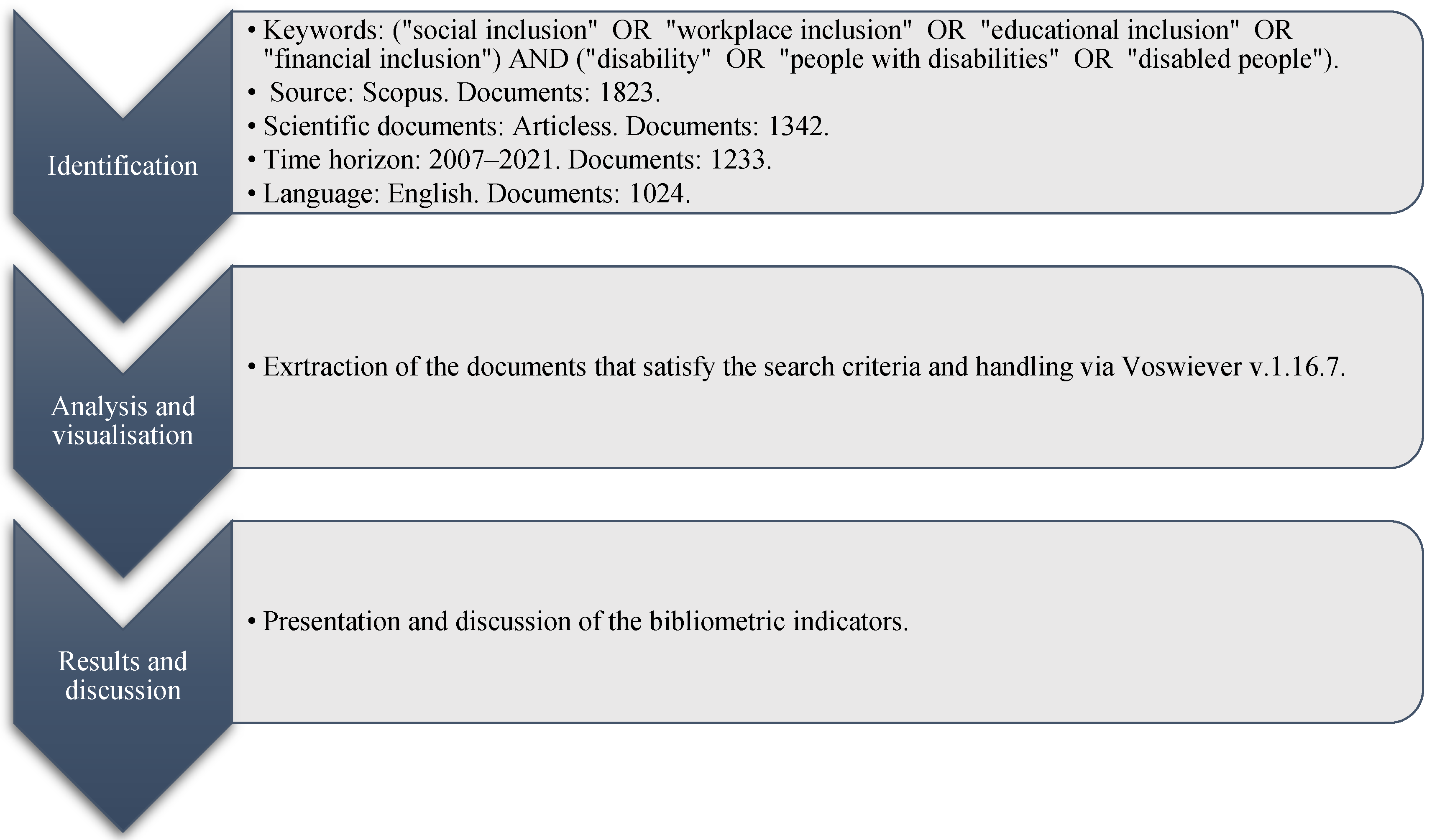
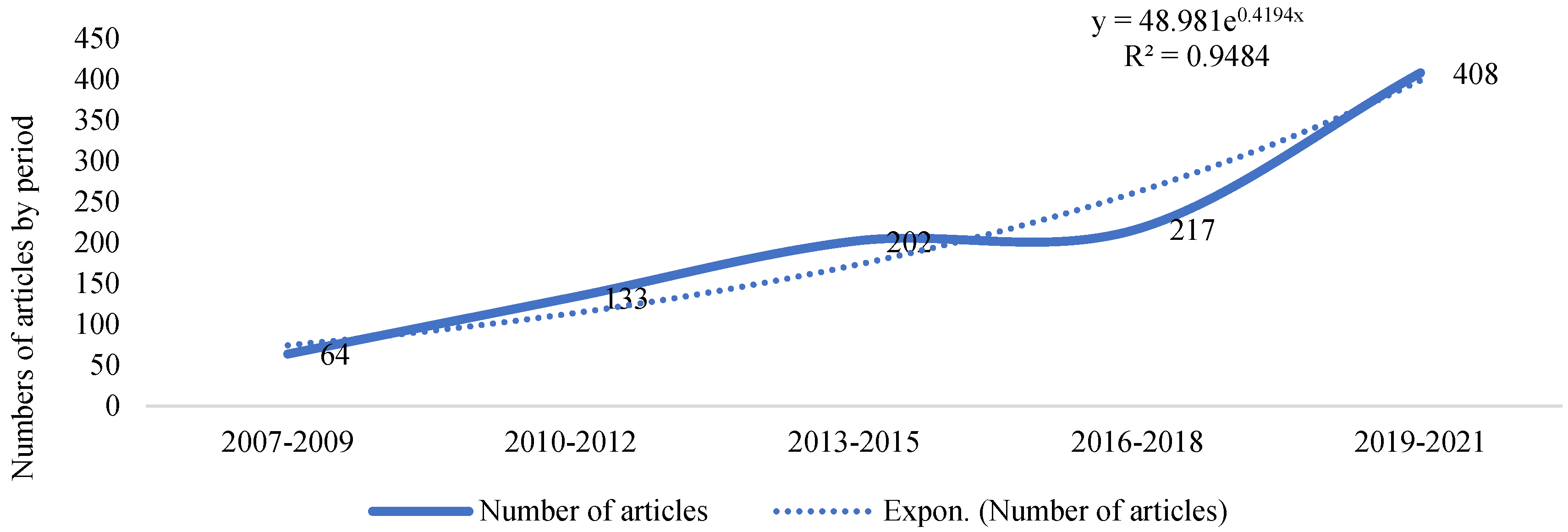
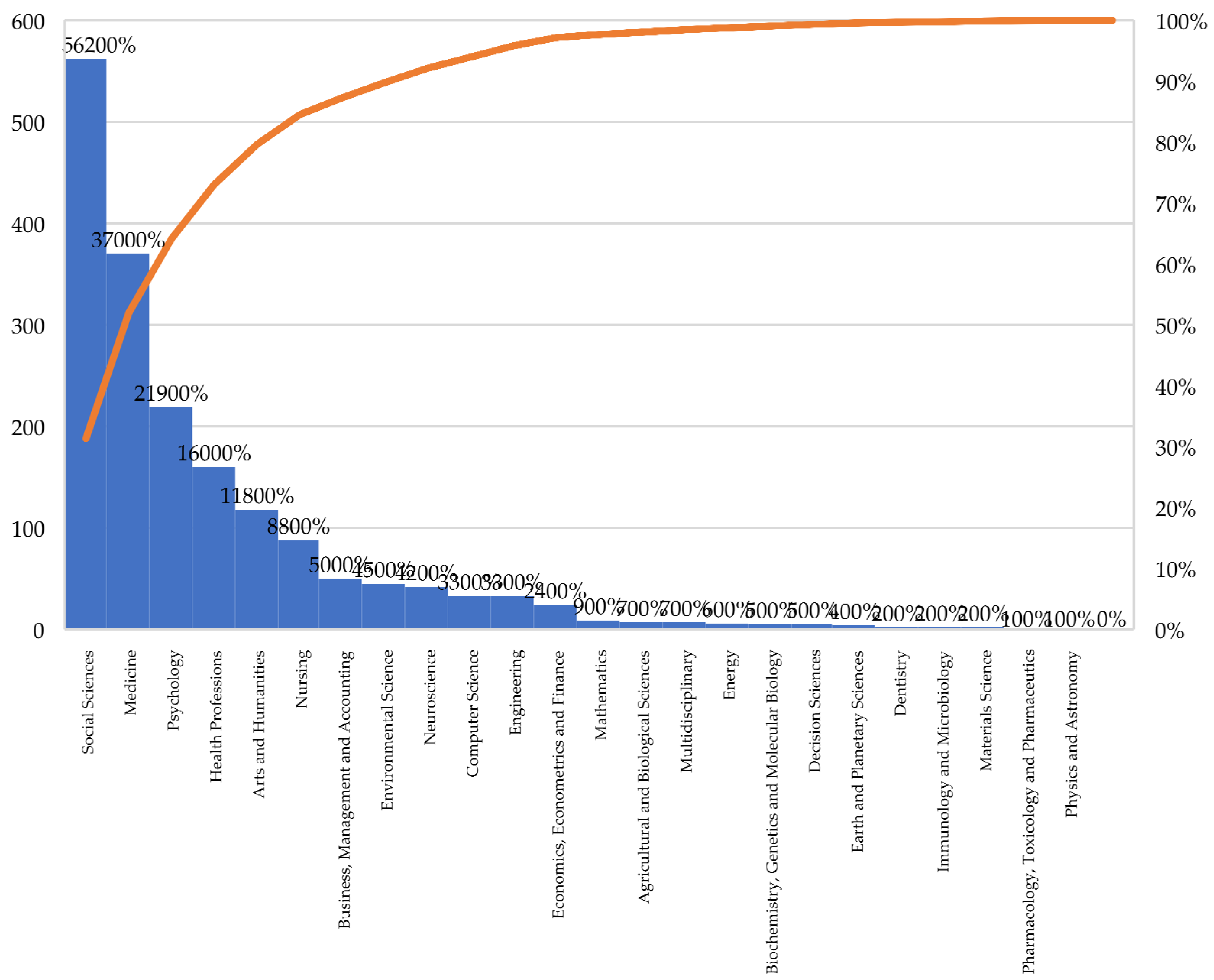
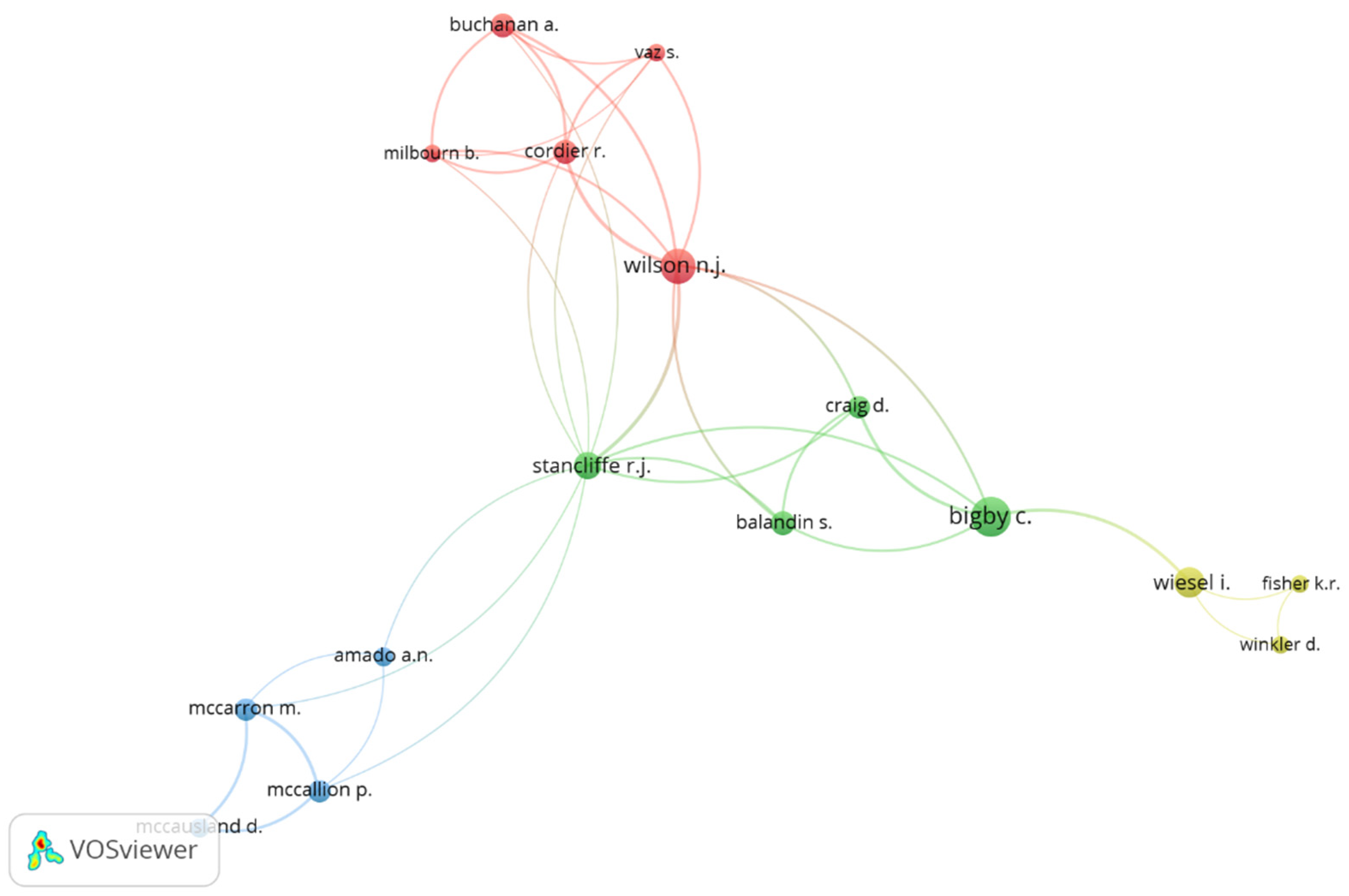
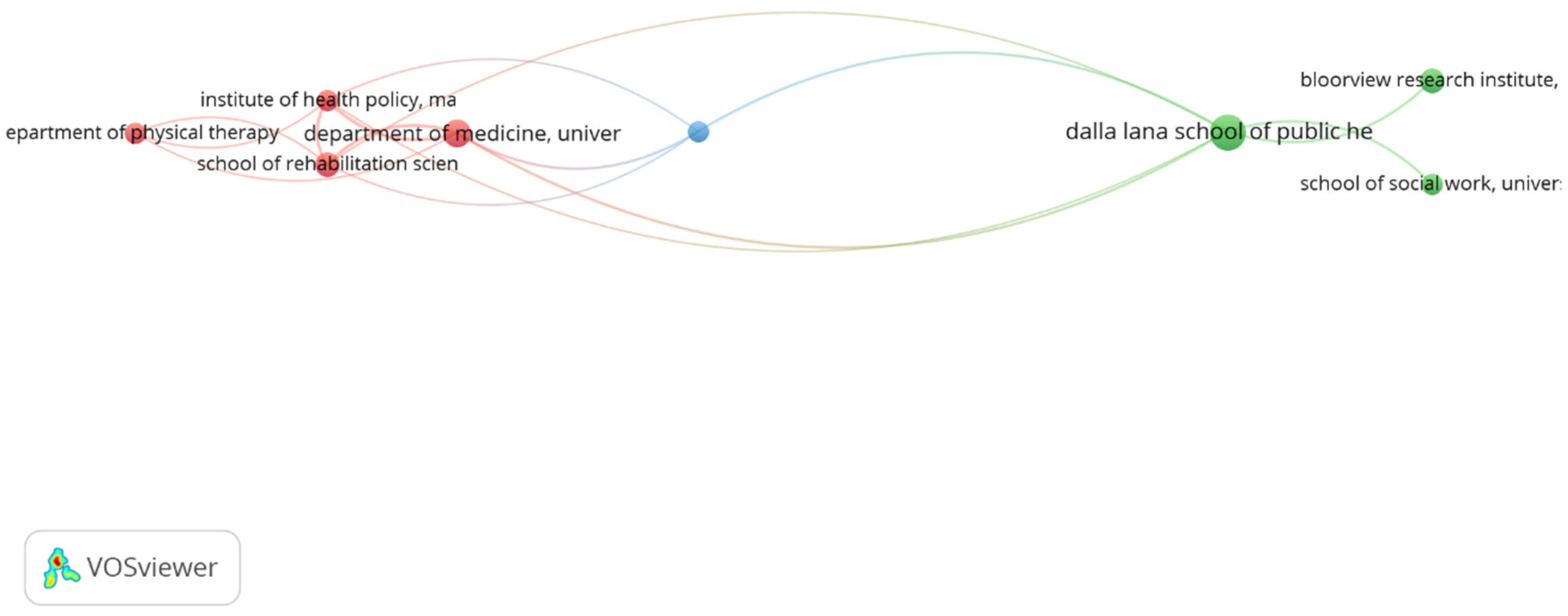
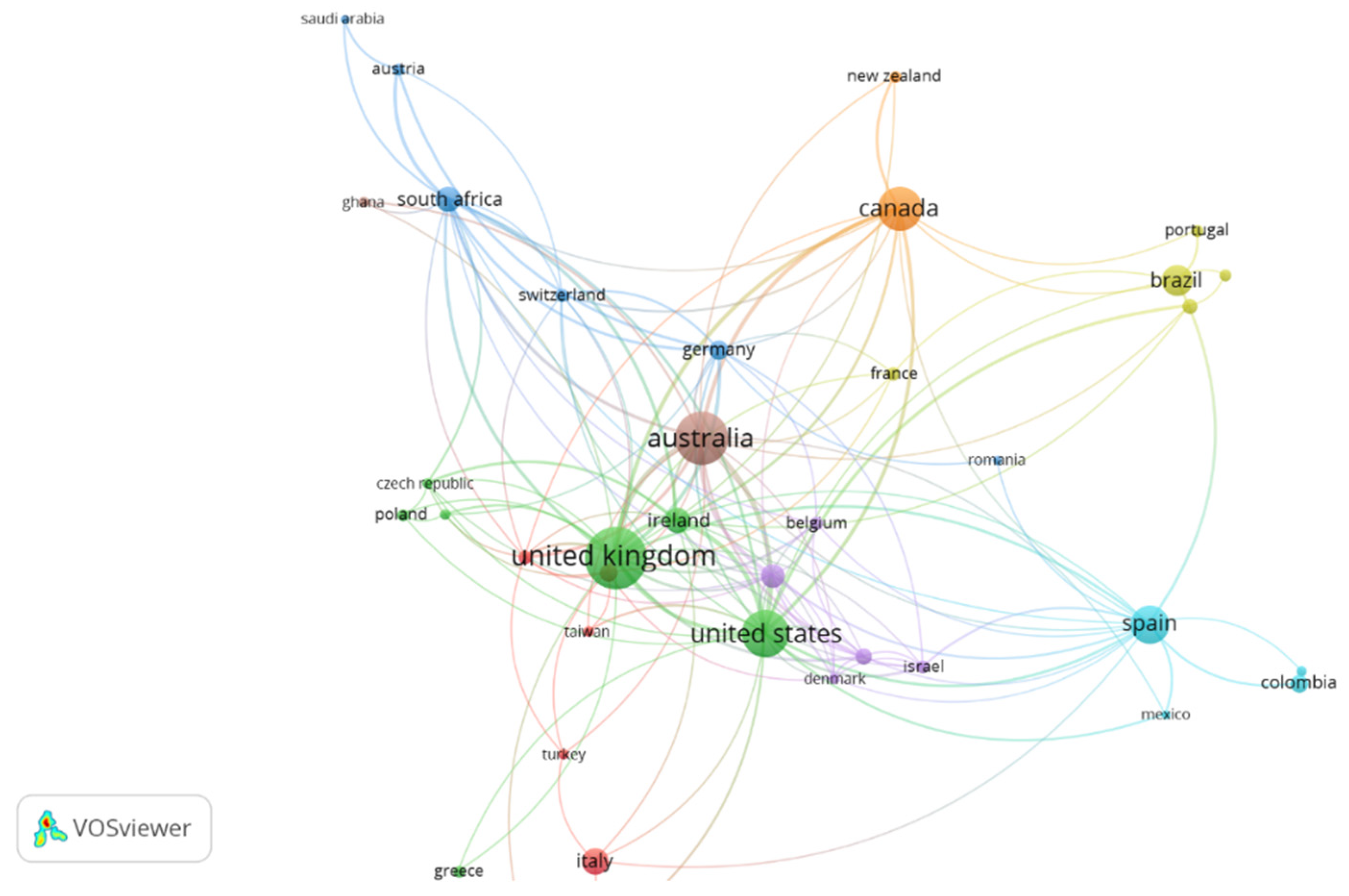
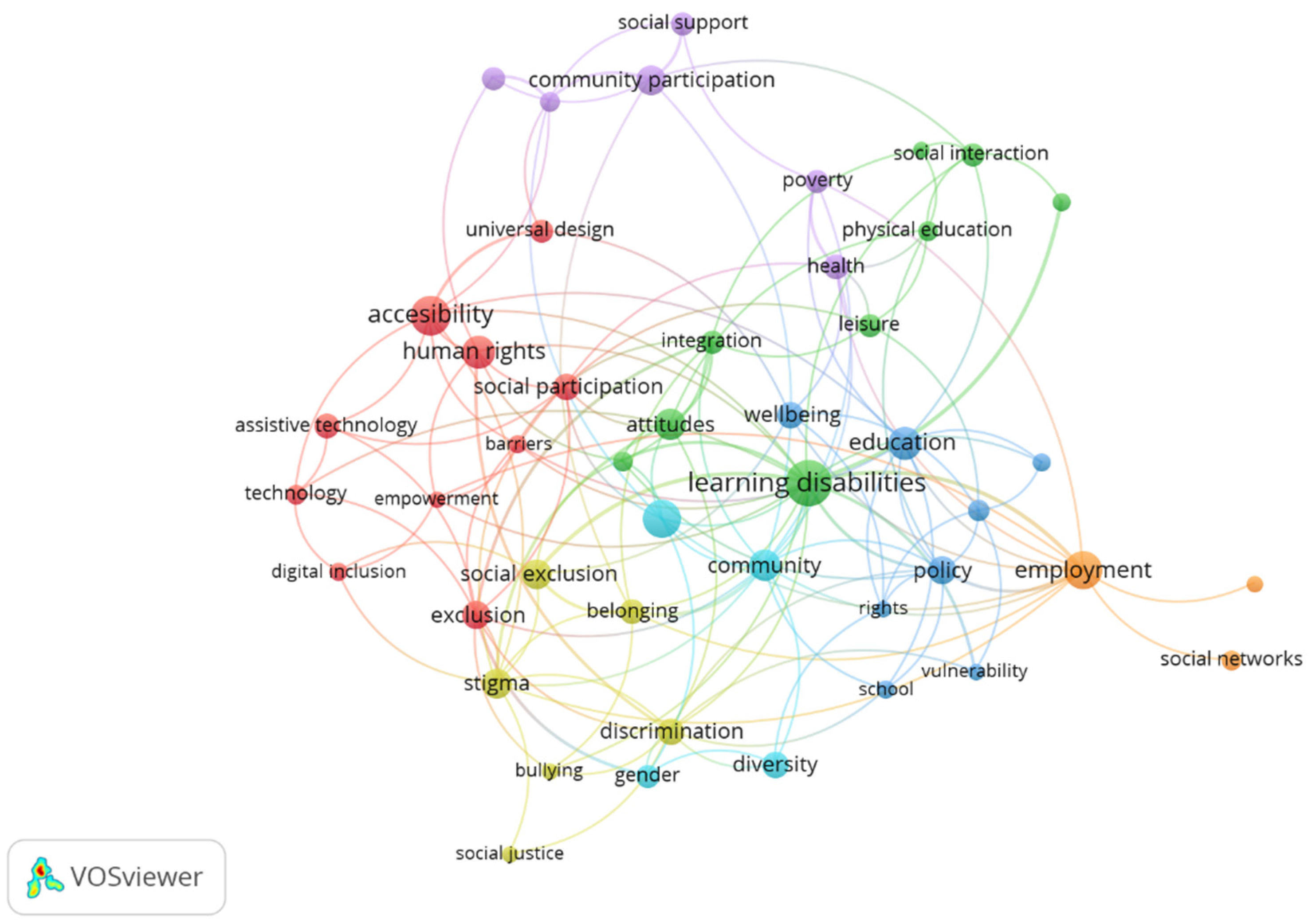
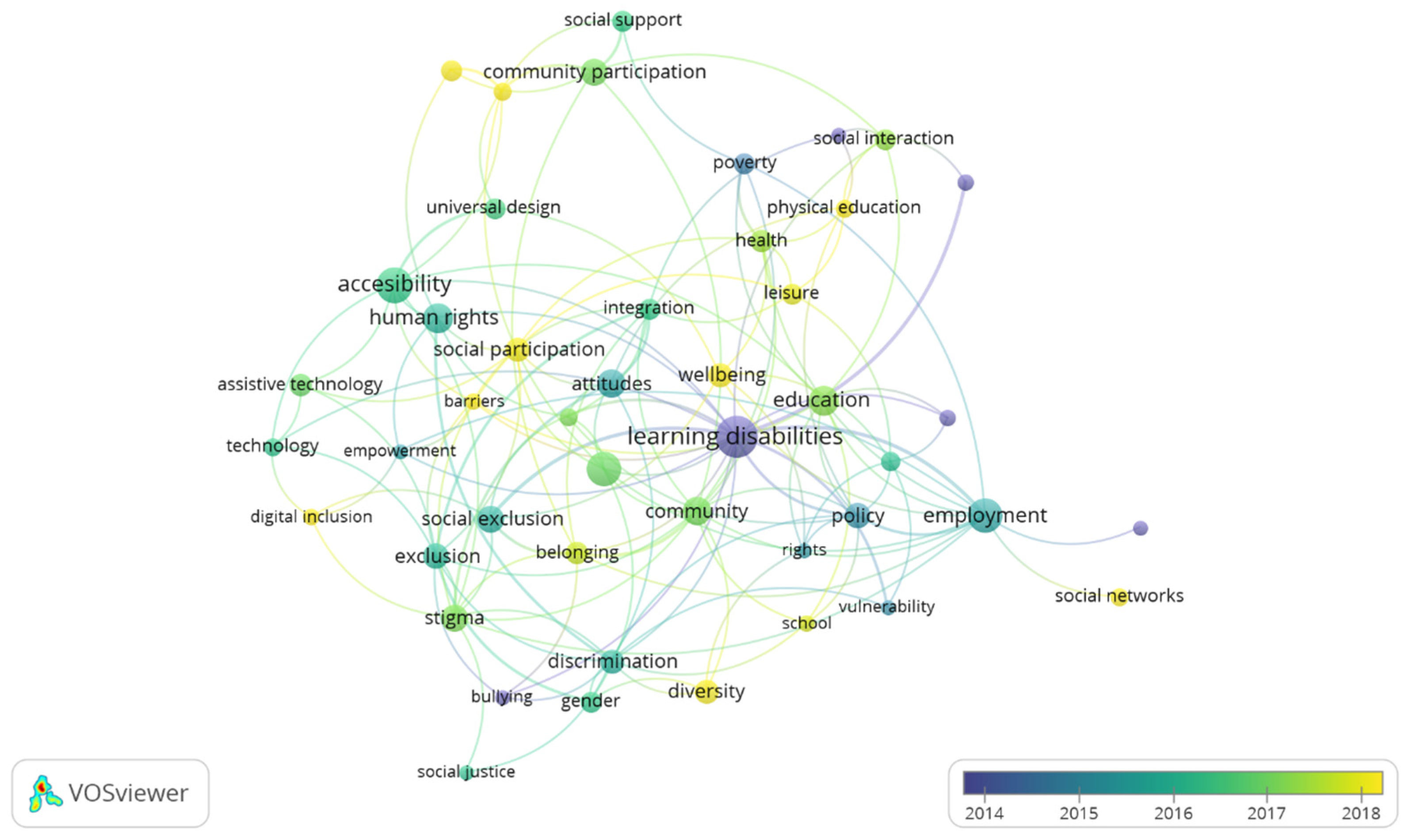
| Year | Articles (A) | Authors (AU) | Countries (C) | Citations (TC) | Average Citations (TC/A) |
|---|---|---|---|---|---|
| 2007–2009 | 64 | 164 | 21 | 59 | 0.92 |
| 2010–2012 | 133 | 332 | 37 | 449 | 3.38 |
| 2013–2015 | 202 | 540 | 44 | 1877 | 9.29 |
| 2016–2018 | 217 | 612 | 51 | 2434 | 11.22 |
| 2019–2021 | 408 | 1297 | 80 | 4813 | 11.80 |
| Total | 1024 | 2945 | 233 | 9632 | 9.41 |
| Authors | Year | Title | Cites |
|---|---|---|---|
| Solish et al. | 2010 | Participation of children with and without disabilities in social, recreational and leisure activities | 197 |
| Hall, E. | 2010 | Spaces of social inclusion and belonging for people with intellectual disabilities | 135 |
| Milner & Kelly | 2009 | Community participation and inclusion: People with disabilities defining their place | 125 |
| McConachie et al. | 2015 | Systematic review of tools to measure outcomes for young children with autism spectrum disorder | 121 |
| Dingle et al. | 2013 | ‘To be heard’: The social and mental health benefits of choir singing for disadvantaged adults | 116 |
| O’Brien et al. | 2008 | Exploring disability from the perspective of adults living with HIV/AIDS: Development of a conceptual framework | 110 |
| Arvanitis et al. | 2009 | Human factors and qualitative pedagogical evaluation of a mobile augmented reality system for science education used by learners with physical disabilities | 107 |
| Amado et al. | 2013 | Social inclusion and community participation of individuals with intellectual/developmental disabilities | 106 |
| Bossaert et al. | 2013 | Truly included? A literature study focusing on the social dimension of inclusion in education | 96 |
| Davidson, J. | 2008 | Autistic culture online: Virtual communication and cultural expression on the spectrum | 96 |
| Authors | A | TC | TC/A | Institution | C | H Index |
|---|---|---|---|---|---|---|
| Bigby, C. | 16 | 340 | 21.25 | La Trobe University | Australia | 13 |
| Wilson, N.J. | 12 | 158 | 13.17 | Western Sydney University | Australia | 7 |
| O’Brien, K.K. | 9 | 209 | 23.22 | University of Toronto Faculty of Medicine | Canada | 7 |
| Solomon, P. | 9 | 85 | 9.44 | McMaster University, Faculty of Health Sciences | Canada | 7 |
| Wiesel, I. | 9 | 164 | 18.22 | University of Melbourne | Australia | 7 |
| Bayoumi, A.M. | 8 | 199 | 24.88 | University of Toronto | Canada | 7 |
| Lindsay, S. | 8 | 163 | 20.38 | Holland Bloorview Kids Rehabilitation Hospital | Canada | 7 |
| McConkey, R. | 7 | 187 | 26.71 | Ulster University | United Kingdom | 4 |
| McPherson, A.C. | 7 | 97 | 13.86 | University of Toronto | Canada | 4 |
| Schwab, S. | 7 | 50 | 7.14 | Universität Wien | Austria | 4 |
| TC/A | ||||||||
|---|---|---|---|---|---|---|---|---|
| Institution | C | A | TC | TC/A | H Index | CI (%) | CI | NCI |
| University of Toronto | Canada | 42 | 617 | 14.69 | 14 | 19.0% | 8.75 | 16.09 |
| La Trobe University | Australia | 25 | 379 | 15.16 | 12 | 4.0% | 16.00 | 15.13 |
| The University of Sydney | Australia | 25 | 410 | 16.40 | 6 | 36.0% | 22.33 | 13.06 |
| UNSW Sydney | Australia | 17 | 248 | 14.59 | 8 | 23.5% | 19.25 | 13.15 |
| Trinity College Dublin | Ireland | 16 | 270 | 16.88 | 4 | 93.8% | 17.00 | 15.00 |
| Holland Bloorview Kids Rehabilitation Hospital | Canada | 16 | 253 | 15.81 | 4 | 0.0% | 0.00 | 15.81 |
| Monash University | Australia | 16 | 179 | 11.19 | 7 | 37.5% | 13.83 | 9.60 |
| University of Melbourne | Australia | 16 | 283 | 17.69 | 3 | 37.5% | 23.33 | 14.30 |
| The University of British Columbia | Canada | 15 | 68 | 4.53 | 6 | 26.7% | 3.50 | 4.91 |
| Queen’s University | Canada | 13 | 534 | 41.08 | 4 | 30.8% | 11.75 | 54.11 |
| TC/A | |||||||||
|---|---|---|---|---|---|---|---|---|---|
| Country | A | TC | TC/A | H Index | NC | Main Collaborators | CI | CI | NCI |
| United Kingdom | 214 | 2800 | 13.08 | 53 | 39 | Australia, Canada, United States, Germany, Ireland | 22.9% | 16.53 | 12.06 |
| Australia | 160 | 1947 | 12.17 | 53 | 34 | United Kingdom, United States, Canada, The Netherlands, India | 70.6% | 12.51 | 11.34 |
| United States | 132 | 1449 | 10.98 | 39 | 28 | Australia, Ireland, Canada, United Kingdom, China | 39.4% | 11.44 | 10.68 |
| Canada | 108 | 1514 | 14.02 | 29 | 14 | Australia, United Kingdom, United States, Ireland, New Zealand | 25.0% | 8.44 | 15.88 |
| Spain | 82 | 391 | 4.77 | 29 | 22 | Brazil, United Kingdom, United States, Colombia, Israel | 25.6% | 7.95 | 3.67 |
| Brazil | 56 | 210 | 3.75 | 18 | 6 | Spain, Portugal, Canada, France, Hong Kong | 16.1% | 4.67 | 3.57 |
| Italy | 40 | 317 | 7.93 | 11 | 5 | Ireland, South Korea, Spain, Turkey, United States | 12.5% | 2.00 | 8.77 |
| South Africa | 38 | 361 | 9.50 | 10 | 27 | Austria, Australia, Ireland, United Kingdom, Germany | 55.3% | 8.14 | 11.18 |
| Ireland | 36 | 493 | 13.69 | 14 | 23 | United States, South Africa, United Kingdom, Canada, Czech Republic. | 61.1% | 13.00 | 14.79 |
| The Netherlands | 34 | 594 | 17.47 | 9 | 18 | Australia, United Kingdom, Ireland, Norway, Spain | 35.3% | 23.83 | 14.00 |
| Journal | A | TC | TC/A | H Index Articles | H Index Journal | SJR | C |
|---|---|---|---|---|---|---|---|
| Disability And Society | 44 | 707 | 16.07 | 13 | 76 | 0.85 (Q1) | United Kingdom |
| Disability And Rehabilitation | 29 | 261 | 9.00 | 10 | 111 | 0.77 (Q1) | United Kingdom |
| Journal of Applied Research in Intellectual Disabilities | 27 | 712 | 26.37 | 8 | 63 | 1.06 (Q1) | United Kingdom |
| British Journal of Learning Disabilities | 21 | 148 | 7.05 | 6 | 39 | 0.63 (Q1) | United Kingdom |
| International Journal of Environmental Research and Public Health | 21 | 57 | 2.71 | 4 | 113 | 0.75 (Q2) | Switzerland |
| Journal of Intellectual Disability Research | 19 | 692 | 36.42 | 9 | 104 | 0.94 (Q1) | United Kingdom |
| International Journal of Inclusive Education | 16 | 222 | 13.88 | 3 | 47 | 0.84 (Q1) | United Kingdom |
| Social Inclusion | 16 | 93 | 5.81 | 6 | 17 | 0.51 (Q2) | Portugal |
| Journal of Intellectual and Developmental Disability | 15 | 226 | 15.07 | 5 | 56 | 0.73 (Q1) | United Kingdom |
| Tizard Learning Disability Review | 15 | 40 | 2.67 | 3 | 17 | 0.27 (Q3) | United Kingdom |
Publisher’s Note: MDPI stays neutral with regard to jurisdictional claims in published maps and institutional affiliations. |
© 2022 by the authors. Licensee MDPI, Basel, Switzerland. This article is an open access article distributed under the terms and conditions of the Creative Commons Attribution (CC BY) license (https://creativecommons.org/licenses/by/4.0/).
Share and Cite
Martínez-Medina, A.; Morales-Calvo, S.; Rodríguez-Martín, V.; Meseguer-Sánchez, V.; Molina-Moreno, V. Sixteen Years since the Convention on the Rights of Persons with Disabilities: What Have We Learned since Then? Int. J. Environ. Res. Public Health 2022, 19, 11646. https://doi.org/10.3390/ijerph191811646
Martínez-Medina A, Morales-Calvo S, Rodríguez-Martín V, Meseguer-Sánchez V, Molina-Moreno V. Sixteen Years since the Convention on the Rights of Persons with Disabilities: What Have We Learned since Then? International Journal of Environmental Research and Public Health. 2022; 19(18):11646. https://doi.org/10.3390/ijerph191811646
Chicago/Turabian StyleMartínez-Medina, Andrés, Sonia Morales-Calvo, Vicenta Rodríguez-Martín, Víctor Meseguer-Sánchez, and Valentín Molina-Moreno. 2022. "Sixteen Years since the Convention on the Rights of Persons with Disabilities: What Have We Learned since Then?" International Journal of Environmental Research and Public Health 19, no. 18: 11646. https://doi.org/10.3390/ijerph191811646





